What is thematic investing?
Our framework can categorise the universe into four broad themes: technology, physical world, social, and broad thematic
Have you thought about investing in cryptocurrencies? What about cannabis? Or maybe you like the idea of funding space exploration? How about artificial intelligence, or robotics?
If you've thought about any of these ideas, you've thought about investing in a theme – and simply put, that's what thematic investing is – an attempt to capitalise on short- or long-term trends by grouping investments around their idea.
The CFA Institute says thematic investing is like "venture capital for asset managers", and that it "isn't just performance chasing, it's performance chasing with a narrative".
It says that although there’s no standard definition, thematic investing tends to be about "capturing the zeitgeist. Or trying to."
Themes are typically about change, like a country evolving from a frontier to an emerging market, a sector that's dramatically transforming, or a new technology seeing widespread adoption.
In one of our Global Thematic Fund Landscape reports, Morningstar researchers Ben Johnson, Kenneth Lamont and Daniel Sotiroff defined the universe of thematic funds as those that select holdings based on their exposure to one or more investment themes.
"These themes may pertain to macroeconomic or structural trends which transcend the traditional business cycle. Examples include demographic shifts or technological advances," they note.
"Our definition includes funds like cannabis ETFs, which hope to capitalise on the legalisation and commercialisation of cannabis globally. We exclude funds that might be useful for making tactical economic calls but lack a cohesive longer-term narrative, such as those that target Japanese exporters."
What’s In, What’s Out?
Morningstar’s definition of thematic funds is generally inclusive, but there are some important omissions.
"We have limited our universe to equity funds, both active and passive. We have excluded other asset classes, most notably fixed-income funds," the authors continue.
"This is because their investment profile is less suited to capturing the growth potential of emerging themes, and consequently the market for these funds is largely nonexistent. Sustainable funds are included, provided they seek to capture a specific theme. This means that alternative energy funds, which aim to capitalise on the transition to a low-carbon economy, are included; but most broad-ESG funds, which select a diverse group of stocks based on ESG scores, fall out of scope."
Funds like gender diversity ETFs, which, at first glance appear thematic, are excluded on the grounds that they are designed to reward a broad set of companies with strong gender-diversity metrics rather than attempting to track the trend toward a more equitable society.
A fund that utilises artificial intelligence or machine learning in its stock-selection process will only be included if it also selects stocks connected with one or more themes.
Sector or Theme?
The line between sectors and themes can be blurry, especially as sector definitions have drifted through time. As a rule of thumb, Morningstar excludes funds that too closely resemble mainline sector funds from our definition of thematic funds.
Perhaps the most challenging distinction to make is between technology sector funds and those that track one or more technology-related themes. To be included in our taxonomy for thematic funds, broad technology funds must explicitly target one or more technology themes, such as disruptive or next-generation technologies.
Moreover, what is considered a theme can change through time. Some funds began as thematic before outgrowing the label. After assessing the global universe of these funds, the authors find that themes cluster into distinct groups. The framework first arranges the universe into four broad buckets: Technology, Physical World, Social, and Broad Thematic.
Technological themes, as their name suggests, target the disruptive growth potential of technological change. These include popular themes like Fintech, Robotics and Automation, and Connectivity. Physical World themes address the management of physical resources. Included in this bucket are funds that facilitate the transition to a low-carbon world, such as alternative energy funds. Themes in the Social bucket deal with structural changes in society. These themes may be politically oriented or focus on demographic changes. Finally, those funds that track multiple themes belonging to any of the above buckets are grouped under the Broad Thematic umbrella.
Themes collected under each of these themes are more-granular theme groupings. For example, Technology themes include fintech, which brings together Fintech but also crowdfunding, blockchain, and digital payments subthemes. As a further example, the Social broad theme includes political themes, which in turn gather funds targeting developments such as the New Silk Road, Chinese Structural Reform, and other policy themes.

